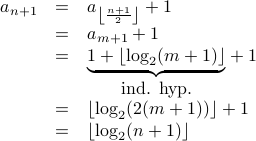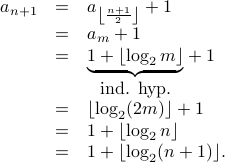Proofs — Mathematical induction (CSCI 2824, Spring 2015)
In this series of notes, we are going to
Provide proofs of various propositions
Ask you to fix some of our proofs.
Practice proving theorems by expressing your argument in a succinct and logically consistent form.
In this page, we will discuss the principle of mathematical induction and prove properties of numbers using induction.
This lecture corresponds to section 2.3 of Ensley and Crawley's book.
Mathematical Induction: General Principle
Mathematical induction is a very common technique for proving properties of natural numbers (and other discrete structures such as sets, relations and trees that we will study very soon).
Here is a video of falling dominoes: Click here!.
Let us imagine an infinitely long sequence of tiles arranged in a straight line (close enough to each other), and let us tip domino number 1.
We wish to argue that every domino will fall. Here is how we can argue:
Base case: The first domino falls (we kicked it, so it falls).
Inductive Step: Whenever a domino numbered
 falls
(or all the dominos numbdered 1 to
falls
(or all the dominos numbdered 1 to  fall),
then its successor numbered
fall),
then its successor numbered  , also falls.
, also falls. Therefore, we conclude that all the dominoes will fall.
The argument above is the crux of induction. To prove a property over all natural numbers  , we may argue as follows:
, we may argue as follows:
The property is true for
 (the first natural number).
(the first natural number).If the property is true for some natural number
 (or if the property is true for all natural numbers up to
(or if the property is true for all natural numbers up to  ),
then it is true for natural number
),
then it is true for natural number  .
.
Weak Induction Proofs
Weak induction offers a simple way for proving a property  for all natural numbers
for all natural numbers  . I.e,
. I.e,  .
.
Step 1: Check the base case. Verify that
 holds.
holds.
Step 2: Write down the Induction Hypothesis, which is in the form
 .
(All you need to do is to figure out what
.
(All you need to do is to figure out what  and
and  are!)
are!)
Step 3: Prove the Induction Hypothesis (that you wrote down). This step usually makes use of the definition of the recursion and also the premise
 .
.
Example 1
Induction can be really useful to guess and prove closed forms of sequences. Consider a simple one:

We have  .
Therefore here is our guess:
.
Therefore here is our guess:  . How do we prove it?
. How do we prove it?
Claim:  .
.
Base Case: We verify that  . So this works.
. So this works.
Induction Hypothesis: For all  , If
, If  then
then  .
.
Proof of induction hypothesis:
Let
 be any given natural number such that
be any given natural number such that  .
. We seek to prove that
 . In fact,
. In fact,
![begin{array}{rcll} a_{n+1} &=& a_n + (2 (n+1) - 1) & [mbox{Apply the recurrence relation}] &=& a_n + 2n + 1 & [mbox{Simplification} ] &=& n^2 + 2n + 1 & [ a_n = n^2, mbox{by induction hypothesis}] &=& (n+1)^2 end{array}](eqs/3090314988764823129-130.png)
Therefore, we have proved that  for all
for all  by induction. QED.
by induction. QED.
Example 2
Theorem. The sum of first  numbers
numbers
 .
.
Base Case: We will verify the fact for  .
Note that
.
Note that  .
.
Induction Hypothesis:

Proof of Induction Hypothesis:
Let
 be any given natural number such that
be any given natural number such that
 holds.
holds.We wish to show that
 .
.We note that
![begin{array}{rcll} Sigma_{j=0}^{n+1} j &=& left( Sigma_{j=0}^n j right) + (n+1) & [mbox{Peel off last term of the summation}] &=& frac{n(n+1)}{2} + (n+1) & [mbox{Assume the induction hypothesis}] &=& frac{n (n+1) + 2 (n+1)}{2} & [mbox{Algebra}] &=& frac{ (n+2)(n+1)}{2}. end{array}](eqs/188806335152392106-130.png)
Hence, by induction we get  for any integer
for any integer
 . QED.
. QED.
Example 3
Let us try the sequence  .
.
First, we guess what the closed form could be by writing down the first few terms:

 .
.
Claim:  .
.
Base Case: For
 , we verify
, we verify  .
.
Induction Hypothesis: For all
 ,
if
,
if  , then
, then  .
.
Proof of induction hypothesis:
 .
.
Hence, by induction we have that
 for all
for all  . QED.
. QED.
Strong Induction Proof: a motivating example
In weak induction, we prove that the number  satisfies
satisfies  by assuming that
by assuming that  (its immediate predecessor) does. That may not always yield
the simplest proof.
(its immediate predecessor) does. That may not always yield
the simplest proof.
First some definitions:
The function  is also called the floor of
is also called the floor of  . It gives the smallest integer that is less than or equal to
. It gives the smallest integer that is less than or equal to  .
.
The function  is also called the ceil of
is also called the ceil of  . It gives the smallest integer that is greater than or equal to
. It gives the smallest integer that is greater than or equal to  .
.
As examples,  whereas
whereas  . For negative numbers, it is a little counter intuitive:
. For negative numbers, it is a little counter intuitive:
 whereas
whereas  .
.
Consider the recurrence  .
.
Here is the result of performing the recurrence on a few values of  .
.

Some of you may recognize the pattern (it is rather important one for CS). Here is the guess:  for
for  with
with  .
.
We can now try proving it by induction. We will first use weak induction.
For all  , If
, If  then
then  .
.
The theorem only applies to natural numbers  . We handle this by simply allowing the base case of induction to start at
. We handle this by simply allowing the base case of induction to start at  .
.
Proof by Weak Induction (a fail…)
Base-Case For  , we verify that
, we verify that  .
.
Inductive Hypothesis:  .
.
This is not easy to prove and infact is strictly not true. This is because  depends on
depends on  and not on
and not on  like our
previous sequences.
like our
previous sequences.
Proof by Strong Induction
Strong induction is different from weak in the inductive hypothesis.
Weak Induction: Assume
 prove
prove  .
. Strong Induction: Assume
 for all
for all  and prove
and prove  .
.
Going back to dominoes, we assume in weak induction that the  domino falls and prove that so does the
domino falls and prove that so does the  .
In strong induction, we assume that all dominoes numbered
.
In strong induction, we assume that all dominoes numbered  fall and prove that in that case the
fall and prove that in that case the  also falls.
also falls.
Claim: For all  , if
, if  ,
then
,
then  .
.
Proof is by strong induction over  .
.
Base-Case: For  , we verify that
, we verify that  .
.
(Advanced note: For strong induction, the base case is really not needed but we will go through it for the sake of uniformity, anyway).
Strong Inductive Hypothesis:
For all  ,
if
,
if  for all
for all  ,
then
,
then  .
.
Proof of the strong induction hypothesis:
Recall the given recursion formula:

We will split this into two cases based on  being odd or not.
being odd or not.
Case 1:
 is odd, i.e,
is odd, i.e,  for some natural number
for some natural number  .
. Then
 .
.Then we have
 .
.
Case 2:
 is even, i.e,
is even, i.e,  for some
for some  .
. Then
 .
.We now compute
 . In fact,
. In fact,

This proves the induction hypothesis. Almost QED… but
there is now an extra proof needed on the side that argues that whenever  is even,
is even,  .
.
For completeness, here is the proof of the side claim.
Side-Claim: For all natural numbers  , if
, if  is even, then
is even, then  .
.
This is an example of a proof by contradiction.
Let us assume otherwise. I.e.,  and
and
 . In other words, we have
. In other words, we have

Since  is odd, we cannot have
is odd, we cannot have  . Therefore,
. Therefore,  . As a result, there is a natural number between
. As a result, there is a natural number between  and
and  . This is a
contradiction. Therefore, it has to be the case that
. This is a
contradiction. Therefore, it has to be the case that  .
.